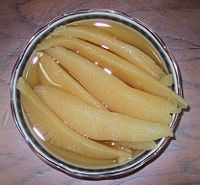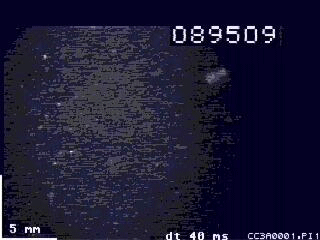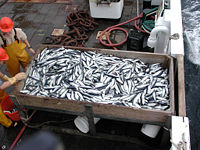Herring
| Clupeidae | ||||||||||
|---|---|---|---|---|---|---|---|---|---|---|
 Atlantic herring, Clupea harengus
| ||||||||||
| Scientific classification | ||||||||||
| ||||||||||
|
Dussumieriinae |
 .
Herring is the common name for any of the various fish comprising the Clupeiformes family Clupeidae, a large family that includes many of the most important food fishes in the world, including the European pilchard (true sardine), Atlantic menhaden, Atlantic herring, Pacific herring, Baltic herring, and the American or Atlantic shad. Although primarily marine, a number of species are freshwater, and some, like the American shad, are anadromous, migrating from their saltwater habitat to freshwater to spawn (Nelson 1994; Herbst 2001). Generally five subfamilies are recognized, with about 66 genera and 216 species (Agbayani 2004). Most members of Clupeidae are small fish and form schools.
.
Herring is the common name for any of the various fish comprising the Clupeiformes family Clupeidae, a large family that includes many of the most important food fishes in the world, including the European pilchard (true sardine), Atlantic menhaden, Atlantic herring, Pacific herring, Baltic herring, and the American or Atlantic shad. Although primarily marine, a number of species are freshwater, and some, like the American shad, are anadromous, migrating from their saltwater habitat to freshwater to spawn (Nelson 1994; Herbst 2001). Generally five subfamilies are recognized, with about 66 genera and 216 species (Agbayani 2004). Most members of Clupeidae are small fish and form schools.
While herring generally is the term used for members of the family (Nelson 1994; Agbayani 2006; ITIS 2004a; Herbst 2001), the term sometimes is used more specifically to refer to members of the subfamily Clupeinae (ITIS 2004b), which also includes sardines, or the genus Clupea (true herrings). This article will focus on the entire herring family.
Herrings move in vast schools, coming in spring to the shores of Europe and America, where they are caught, salted and smoked in great quantities. Canned "sardines" (or pilchards) seen in supermarkets may actually be sprats or round herrings.
In The Netherlands, herring have played a major role in historical and economic development dating back to the 14th century.
Overview and description
Clupeidae is a primarily marine (some freshwater and some anadromous) assemblage of herrings (shads, sprats, sardines, pilchards, and menhadens) (Nelson 1994). Members of the family have a single dorsal fin and tend to be silvery colored fish. Unlike most other fish, they have soft dorsal fins that lack spines, though some species have pointed scales that form a serrated keel. They have no lateral line and have a protruding lower jaw. Members of this family are characterized by absent or small teeth; two long, rod-like postcleithra in most; slender shape; and an anal fin usually with 12-29 rays, but up to 38 in members of the subfamily Dussumieriinae (Nelson 1994).
Members of most species form schools and are found near the surface feeding on [[plankton) (Nelson 1994).
Most members of Clupeidae are small fish, less than 25 centimeters (10 inches), although Tenualosa ilisha (a shad) reaches 60 centimeters (two feet) (Nelson 1994). The Baltic herring is small, usually about 14 to 18 centimeters in length, the Atlantic herring can grow to about 46 cm (18 inches) in length and weigh up to 1.5 pounds (700 grams), and the Pacific herring grow to about 38 centimeters (15 inches).
Five subfamilies typically are recognzied: Dussemieriinae (round herrings), Pellonulinae (freshwater herrings), Clupeinae, Alosinae (shads), and Dorosomatinae (gizzard shads). Although Pellonulinae commonly are known as the freshwater herrings, and most species occur in freshwater, some are found in marine waters (Nelson 1994).
The herrings are placed into 66 genera and 216 species (Agbayani 2004). Nelson (1994) notes that about 50 of the species are freshwater, occasionally entering brackish water, while others are anadromous or otherwise extend into freshwater, but most are marine. Most of the freshwater species are in Africa (Nelson 1994).
Feeding and predation
Young herring feed on phytoplankton and as they mature they start to consume larger organisms. Adult herring feed on zooplankton, tiny animals that are found in oceanic surface waters, and small fish, and fish larvae. Copepods and other tiny crustaceans are the most common zooplankton eaten by herring.
During daylight herring stay in the safety of deep water, feeding at the surface only at night when there is less chance of predation. They swim along with their mouths open, filtering the plankton from the water as it passes through their gills.
Predators of adult herring include seabirds, dolphins, porpoises, seals, sea lions, whales, and humans. Sharks, dog fish, tuna, cod, salmon, halibut and other large fish also feed on adult herring. Many of these animals also prey on juvenile herring.
Commercial and culinary importance
Herring are an important economic fish. Adult fish are harvested for their meat and eggs. The most important commercial species include:
- Atlantic menhaden, Brevoortia tyrannus
- Atlantic herring, Clupea harengus
- Baltic herring, Clupea harengus membras
- Pacific herring, Clupea pallasii
- European pilchard, Sardina pilchardus
Cuisine
Herring has been a known staple food source since 3000 B.C.E. There are numerous ways the fish is served and many regional recipes: eaten raw, fermented, pickled, or cured by other techniques. The fish was sometimes known as "two-eyed steak."
Herring are very high in healthy long-chain Omega-3 fatty acids (May 2008), EPA, and DHA. They are a source of vitamin D. Large Baltic herring slightly exceeds recommended limits with respect to PCB and dioxin. Nevertheless, the health benefits from the fatty acids generally are considered more important than the theoretical risk from dioxin; their cancer-reducing effect is statistically stronger than the cancer-causing effect of PCB's and dioxins (Evira 2006a). The contaminant levels depend on the age of the fish, which can be inferred from their size. According to recommendations of the Finish Food Safety Authority, Baltic herrings larger than 17 centimeters may be eaten twice a month, while herrings smaller than 17 centimeters may be eaten freely (Envira 2006b).
Pickled herring is a delicacy popular in Europe and has become a basic part of Jewish cuisine. Most cured herring uses a two-step curing process. Initially, herring is cured with salt to extract water. The second stage involves removing the salt and adding flavorings, typically a vinegar, salt, sugar solution to which ingredients like peppercorn, bay leaves and raw onions are added.
In Scandinavia, once the pickling process is finished and depending on which of the dozens of classic herring flavorings are selected, it is usually enjoyed with dark rye bread, crisp bread, or potatoes. This dish is popular at Christmas and Midsummer, where it is enjoyed with akvavit. In Iceland, a blald is a young pickled herring given to a child as a special holiday treat.
Pickled herrings are also common in Ashkenazi Jewish cuisine, perhaps best known for forshmak salad known in English simply as "chopped herring." Pickled herring can also be found in the cuisine of Hokkaidō in Japan, where families traditionally preserved large quantities for winter.
The word rollmops, borrowed from German, refers to a pickled herring fillet rolled (hence the name) into a cylindrical shape around a piece of pickled cucumber or an onion.
In Sweden, Baltic herring is fermented to make surströmming.

A typical Dutch delicacy is raw herring (Hollandse Nieuwe). This is typically eaten with raw onions. Hollandse nieuwe is only available in spring when the first seasonal catch of herring is brought in. This is celebrated in festivals such as the Vlaardingen Herring Festival. The new herring are frozen and enzyme-preserved for the remainder of the year.
Herring is also canned and exported by many countries. A sild is an immature herring that are canned as sardines in Iceland, Sweden, Norway or Denmark.
Very young herring are called whitebait and are eaten whole as a delicacy.
A kipper is a split and smoked herring, a bloater is a whole smoked herring, and a buckling is a hot smoked herring with the guts removed. All are staples of British cuisine. According to George Orwell in The Road to Wigan Pier, the Emperor Charles V erected a statue to the inventor of bloaters.
In Scandinavia, herring soup is also a traditional dish.
In Southeast Alaska, western hemlock boughs are cut and placed in the ocean before the herring arrive to spawn. The fertilized herring eggs stick to the boughs, and are easily collected. After being boiled briefly the eggs are removed from the bough. Herring eggs collected in this way are eaten plain or in herring egg salad. This method of collection is part of Tlingit tradition.
Herring in popular culture
Figuratively, a red herring is a false lead in a mystery. In this context, red means smoked, and a smoked herring has such a strong smell that it can be used to create a false scent that causes hunting dogs to lose a track.
Classification
Genera
- Subfamily Dussumieriinae (round herrings)
- Dayella
- Dussumieria
- Etrumeus
- Gilchristella
- Jenkinsia
- Luisiella
- Sauvagella
- Spratelloides
- Spratellomorpha
- Subfamily Clupeinae
- Amblygaster
- Clupea
- Clupeonella
- Escualosa
- Harengula
- Herklotsichthys
- Lile
- Opisthonema
- Subfamily Alosinae (shads, menhadens)
- Alosa
- Brevoortia
- Ethmalosa
- Ethmidium
- Gudusia
- Hilsa
- Tenualosa
- Subfamily Pellonulinae (freshwater herrings)
- Knightia (prehistoric)
- Clupeichthys
- Clupeoides
- Congothrissa
- Corica
- Cynothrissa
- Ehirava
- Hyperlophus
- Laeviscutella
- Limnothrissa
- Microthrissa
- Minyclupeoides
- Odaxothrissa
- Pellonula
- Poecilothrissa
- Potamalosa
- Potamothrissa
- Stalothrissa
- Subfamily Dorosomatinae (gizzard shads)
- Anodontostoma
- Clupanodon
- Dorosoma
- Gonialosa
- Konosirus
- Nematalosa
- Incertae sedis
- Erichalcis
- Ilisha
- Nannothrissa
- Neoopisthopterus
- Pellona
- Platanichthys
- Ramnogaster
- Rhinosardinia
- Sardina
- Sardinella
- Sardinops
- Sierrathrissa
- Sprattus
- Stolothrissa
- Strangomera
- Thrattidion
Species in the Clupea genus
Clupea alba
Clupea bentincki
Clupea caspiopontica
Clupea chrysotaenia
Clupea elongata
Clupea halec
Clupea harengus
Clupea inermis
Clupea leachii
Clupea lineolata
Clupea minima
Clupea mirabilis
Clupea pallasii
Clupea sardinacaroli
Clupea sulcata
ReferencesISBN links support NWE through referral fees
- Agbayani, E. 2004. Family Clupeidae - Herrings, shads, sardines, menhadens FishBase. Retrieved June 2, 2008.
- Agbayani, E. 2006. Term: Herrings FishBase. Retrieved June 2, 2008.
Risks and benefits are clarified by food risk assessment
01.12.2006 - 15:46 2006a. The Finnish Food Safety Authority Evira [1]
2006b. .[2]
- Integrated Taxonomic Information System (ITIS). 2004a. Clupeidae ITIS Taxonomic Serial No.: 161700. Retrieved June 2, 2008.
- Integrated Taxonomic Information System (ITIS). 2004b. Clupeinae ITIS Taxonomic Serial No.: 551153. Retrieved June 2, 2008.
- "Clupea". FishBase. Ed. Ranier Froese and Daniel Pauly. January 2006 version. N.p.: FishBase, 2006.
- O'Clair, Rita M. and O'Clair, Charles E., "Pacific herring," Southeast Alaska's Rocky Shores: Animals. pg. 343-346. Plant Press: Auke Bay, Alaska (1998). ISBN 0-9664245-0-6
- Bender, D. A., and A. E. Bender. 2005. A Dictionary of Food and Nutrition. New York: Oxford University Press. ISBN 0198609612.
- Food and Agriculture Organization and World Health Organization (FAO/WHO). 1995.
- Herbst, S. T. 2001. The New Food Lover's Companion: Comprehensive Definitions of Nearly 6,000 Food, Drink, and Culinary Terms. Barron's Cooking Guide. Hauppauge, NY: Barron's Educational Series. ISBN 0764112589.
- Mayo Clinic. 2008. Cardiovascular Benefits Of Omega-3 Fatty Acids Reviewed
ScienceDaily (Mar. 12, 2008) Cardiovascular Benefits Of Omega-3 Fatty Acids Reviewed</ref>,
- Nelson, J. S. 1994. Fishes of the World 3rd edition. New York: John Wiley & Sons. ISBN 0471547131.
- Sepkoski, J. 2002. A compendium of fossil marine animal genera Bulletins of American Paleontology 364: 560. Retrieved May 22, 2008.
External links
- Guide to Responsible Sourcing of Herring - produced by Seafish http://www.seafish.org/upload/b2b/file/fact_sheets/Herring%20Factsheet2%20A4s.pdf
- clupea.net
- Herring "communicate" by flatulence from newscientist.com
- Atlantic Herring from the Gulf of Maine Research Institute
Credits
New World Encyclopedia writers and editors rewrote and completed the Wikipedia article in accordance with New World Encyclopedia standards. This article abides by terms of the Creative Commons CC-by-sa 3.0 License (CC-by-sa), which may be used and disseminated with proper attribution. Credit is due under the terms of this license that can reference both the New World Encyclopedia contributors and the selfless volunteer contributors of the Wikimedia Foundation. To cite this article click here for a list of acceptable citing formats.The history of earlier contributions by wikipedians is accessible to researchers here:
The history of this article since it was imported to New World Encyclopedia:
Note: Some restrictions may apply to use of individual images which are separately licensed.



